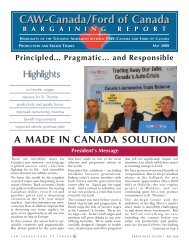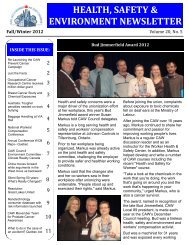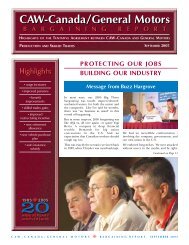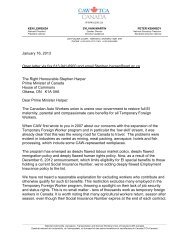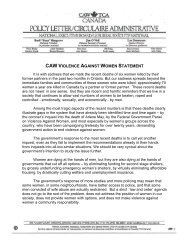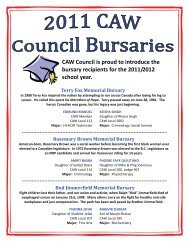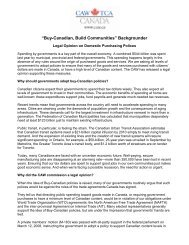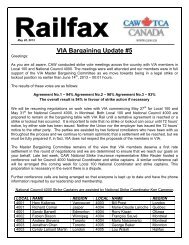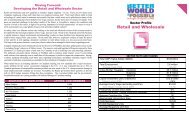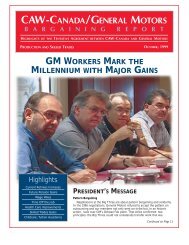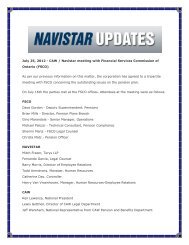CAW Book 3 660zzB web (Page 20 - 21)
CAW Book 3 660zzB web (Page 20 - 21)
CAW Book 3 660zzB web (Page 20 - 21)
Create successful ePaper yourself
Turn your PDF publications into a flip-book with our unique Google optimized e-Paper software.
THE STRIKE WAS A SUCCESS NOT JUST IN WINNING THE STRUGGLE FOR UNION SECURITY,<br />
BUT ALSO IN ESTABLISHING THE LEGITIMACY OF UNIONS IN CANADA.<br />
T H E F O R D W I N D S O R<br />
STRIKE1945<br />
In 1945, UAW Local <strong>20</strong>0 at Ford’s Windsor plant made “union security” a key demand.<br />
Many employers wished to use the end of the war as an excuse to return to conditions as<br />
they were prior to the war when workers were unable to form unions. In order to ensure<br />
that this did not happen, Local <strong>20</strong>0 demanded that the company agree to a union shop as<br />
well as automatic dues check-off. Ford had agreed to these terms with its workers at Ford’s<br />
River Rouge plant in Detroit in 1941. Union security was needed to allow the union to<br />
effectively represent its members. During the war, the UAW had to collect dues directly<br />
from its members on a monthly basis. With thousands of members, this became a full-time<br />
activity and made it difficult for the union to function.<br />
Negotiations stalled and on September 12, 1945, 11,000 Ford workers went on strike and<br />
stayed out for 99 days. The 1945 Windsor Ford strike was historic. It not only established<br />
the principle of union security, but it also ensured that the gains labour won during the<br />
full employment years of the war would not be reversed. Unions could take their place as<br />
a legitimate part of Canadian society. As the strike started, World War II was just coming<br />
to an end. Thousands of soldiers were returning to Canada and re-entering the work force.<br />
Women marching in the picket line on Charles Street, Windsor<br />
THE RAND FORMULA AND THE STRUGGLE FOR UNION SECURITY 1
On November 5, as tensions mounted, 8,000 workers from 25 plants organized by Local<br />
195 walked off the job in solidarity with the Ford workers. They stayed out for one month<br />
with no strike pay. The next day, the union, anxious to avoid bloodshed, formed a<br />
blockade of cars and trucks stretching <strong>20</strong> blocks around the giant Ford plant.<br />
Below is how UAW Canadian Director George Burt described the Windsor blockade:<br />
Picket Line at Plant1, blocking the Sandwich Street company gates, went up on September 12, 1945<br />
“We were not well enough off in those days to have the thousands of people with cars they had in<br />
the United States, but most of the workers with cars did respond, and they established a barricade<br />
so that when public cars came down Riverside Drive they unwittingly were trapped in the<br />
congestion and reinforced our park in-siege.<br />
The city buses were organised, and I don’t know whether they acted with aforethought, but they<br />
drove into the jam and tangled into this great clot of cars. We did make one mistake. There was a<br />
fellow with a load of fish, and at our invitation he left his truck in the middle of the demonstration.<br />
It stayed there for days and when a spot of warm weather came along we very much regretted we<br />
had extended our hospitality to the fish monger.”<br />
Where Was George Burt?, UAW Pamphlet<br />
Corporations were looking to return to the pre-war years when they had greater control<br />
over workers. In taking on the largest company in the country, Ford workers led the way<br />
in establishing a mood of confidence that Canadian workers could continue to fight to<br />
make gains.<br />
THE BLOCKADE<br />
During the strike, the strikers closed the company’s powerhouse down, shutting off the<br />
heating system for the plant. As winter approached, pressure built to reopen the<br />
powerhouse. The local Police Commission proposed using the police, over-ruling the<br />
Mayor of Windsor, Art Reaume, who supported the strike. At the same time, the province<br />
sent in hundreds of OPP and RCMP officers. Roy England, President of UAW Local <strong>20</strong>0,<br />
expressed his outrage at the growing threat of police aggression:<br />
“The proposals of members of the Police Commission to use police to break through picket lines to<br />
escort watchmen in the powerhouse is nothing less than an attempt at strike-breaking. This is not<br />
what our returning veterans and the production workers fought for during the war in which they<br />
so gloriously upheld Canada’s part in victory.”<br />
Mary E. Baruth-Walsh & G. Mark Walsh, Strike: 99 Days On The Line<br />
Royal Canadian Mounted Police officers flown in from Ottawa disembark from chartered plane, November 5, 1945<br />
2<br />
WHERE DID OUR RIGHTS COME FROM?<br />
THE RAND FORMULA AND THE STRUGGLE FOR UNION SECURITY 3
Three days later, the blockade was removed. It had been a success. The police and the<br />
RCMP did not intervene. On November 23, following the resumption of negotiations, the<br />
powerhouse was reopened with the permission of Local <strong>20</strong>0.<br />
The strike received strong support from the Windsor community. Soldiers back from the<br />
front lines marched in solidarity rallies. Church groups and local businesses pitched in to<br />
help the strikers and their families. The Women’s Auxiliary fed 11,000 picketers. Financial<br />
support came from unions across the country.<br />
Here is an excerpt from a letter from the Ford Strike Committee in 1945 to<br />
Toronto unions appealing for financial assistance:<br />
“No strike in the history of Canada has caught the imagination and the sympathy<br />
of the Canadian workers like the present Ford strike...they have put up an epic<br />
and heroic struggle not only for union security but also for increased<br />
vacations with pay and an insurance plan, for increased wages, an<br />
annual living wage and other points so essential for workers in order<br />
to gain economic security. We urge upon you and your membership to make your contributions to<br />
the Ford strikers at this time, because the outcome of the Ford Strike will determine labour<br />
conditions throughout Canada for years to come.”<br />
Mary E. Baruth-Walsh, G. Mark Walsh, Strike: 99 Days On The Line<br />
THE STRIKE ENDS<br />
On November 29, the Federal Government tabled a proposal to end the strike.<br />
The proposal included binding arbitration on the union shop and dues check-off issues.<br />
On December 16, after 99 days on strike, the membership voted to accept the terms and<br />
allow the issue of union security to go to third party arbitration on the condition that the<br />
arbitrator be someone who was sympathetic to the union. The decision of the arbitrator,<br />
Justice Ivan Rand, provided for the dues check-off, but not for the union shop.<br />
The strike was a success not just in winning the struggle for union security, but also in<br />
establishing the legitimacy of unions in Canada. This gave the Canadian labour movement<br />
the confidence to fight for post-war gains. George Burt summed up the view of the union<br />
in his report to UAW Canadian Council following the strike:<br />
“It is our belief that we have won the strike and we have<br />
confidence that the weight of this strike has had the effect<br />
of shaking the government into a greater realization of the<br />
problems of organized labour and has awakened the<br />
Canadian people to the realization that the success of postwar<br />
rehabilitation depends a great deal upon the labour<br />
movement. We feel the strike will have an effect of<br />
softening the manufacturers when our demands for wage<br />
increases are made public.”<br />
Report to Canadian Council, January 19 and <strong>20</strong>, 1946.<br />
Local <strong>20</strong>0 was also looking for medical benefits, two<br />
weeks paid vacation and seniority rights for veterans.<br />
In a “union shop” everyone working in a plant would<br />
automatically be members of the union. With “dues<br />
check-off” the company would deduct union dues from<br />
the members’ pay cheques and hand the dues over to<br />
the union.<br />
Henry Howarth in the strike-supporter “sound-car”, November 2, 1945<br />
A blockade had been used to great effect by the UAW at<br />
Ford in Detroit in 1941.<br />
4<br />
WHERE DID OUR RIGHTS COME FROM?<br />
THE RAND FORMULA AND THE STRUGGLE FOR UNION SECURITY 5



